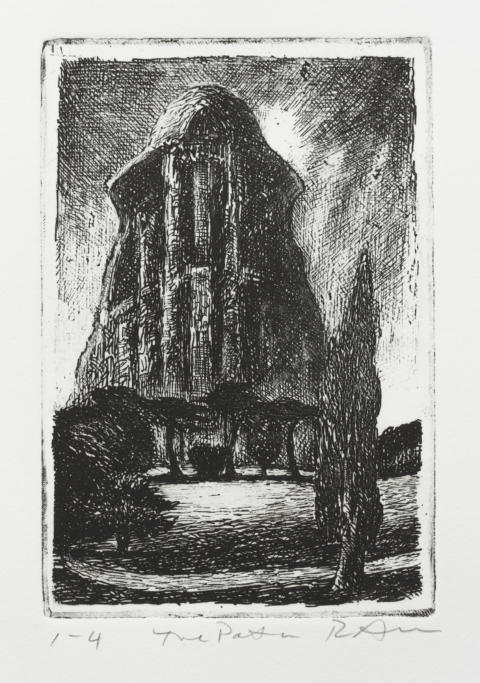
Etching. Dominating the scene is a tall circular building with a curved outline, tapering towards the top. It is surmounted by a dome; a light shines behind the dome at the right. The sky is densely cross-hatched at the top, but fades into whiteness at the horizon. In front of the building is a garden with a curving path, a cypress in the right foreground, small trees at the left and three trees and a bush. There are two variant impressions of this state.
Rays of light now emanate from the light source behind the dome at right; they have been burnished in.
The light rays have contracted, due to the addition of an area of oblique hatching at the top of the plate; it emerges from the corners and the top, and is directed towards the dome. The lower part of the sky has been burnished and is now markedly lighter and more modulated tonally; the lower left edge of the building has also been burnished. Several horizontal lines have been added to the path at the far left.
The light source to the right of the dome has become even more contained as the etched lines around the building have been extended downward. Several oblique hatched lines have been added to the lower left of the dome. Accents of deep etching have been added to the upper corners of the plate, to the building itself and to the tall cypress. The patch of light ground in front of the building has been darkened with the addition of broken lines of horizontal shading.
The left contour of the dome has been clearly outlined with etching, and the left of the building has received more dark accents. There are two variant impressions of this state.
The background, and the trees at the lower left, have been burnished back and then re-etched with hatching and cross-hatching. There are two variant impressions of this state.
The area immediately to the left of the top of the cypress has been lightly burnished to make it stand out more clearly.
- Catalogue Number
- E.166
- Title and Date
- The path
2011; reworked and retitled 2012
- Subsequent Title(s)
- The path II
- Description of Featured Image
- Dominating the scene is a tall, circular building with a curved profile, tapering towards the top. It is surmounted by a dome; a light shines behind the dome at the right. The sky is densely cross-hatched at the top of the image, but fades into whiteness at the horizon. In front of the building is a garden with a curving path, a cypress in the right foreground, small trees at left and three trees and a bush directly in front of the tower. This is an impression from the first edition. The plate underwent two further state changes, and was editioned for a second time in 2012, with the title The path II.
- Where Made
- Alphington, Melbourne
- Medium Category and Technique
- Intaglio Print: Etching, burnishing and drypoint on copper
- Support
- Wove paper. Identified papers: BFK Rives paper with watermark: ‘BFK RIVES / FRANCE’ with infinity symbol; Somerset paper with watermark: ‘somerset / ENGLAND’; Arches paper with watermark: ‘ARCHES / FRANCE’ with infinity symbol.
- Dimensions
-
Image size: 148 x 100 mm
Matrix size: 148 x 100 mm - Artist’s Record Number
- RAE.203 (2011), RAE.208 (2012)
- Printer(s) and Workshop(s)
- All state impressions printed by Rick Amor in his Alphington studio. First and second editions printed by Rosalind Atkins at Kate Herd’s studio, Alphington.
- Summary Edition Information
- Eight states. Two editions. First edition: edition of ten numbered impressions, 2011 (The path). Second edition: edition of ten numbered impressions, 2012 (The path II).
- Exhibitions
- Art Gallery of South Australia 2016–17: Art Gallery of South Australia, Adelaide, Rick Amor: Contemporary Romantic, 2 December 2016 – 30 April 2017 [no catalogue], ed. 1/10, 2012 (The path II).
- Collections
- State Library of Victoria, Melbourne: eight state impressions, numbered 1-1 through 1-7, 2-7, all dated 2011 (The path); ed. 2/10, dated 2011 (The path); four state impressions, numbered 1-1, 2-1, 1-2, 2-2, all dated 2012 (The path II); ed. 2/10, dated 2012 (The path II).
- Art Gallery of South Australia, Adelaide: ed. 3/10, dated 2011 (The path) (promised gift); ed. 1/10, dated 2012 (The path II) (promised gift).
- Comment
The tower in this etching was inspired by the city tower with domed roof in Fritz Lang’s 1927 film Metropolis, although here the structure has been removed from its urban context and placed in a garden setting. The garden is based on that in Amor’s earlier plein-air painting of a public garden in the Melbourne suburb of Northcote; this work includes a distant view of a public housing block, which has been replaced in the print with the tower from Metropolis.
The etching was made after a painting of the same title (not exhibited as of December 2016), in which the tower, depicted in the pale, unearthly colours of pink, grey, green and yellow, appears like a vision. The transformation of the motif through the eight states and two editions of the print reflects Amor’s search for the graphic equivalent of the painted tower’s eerie, surreal quality.
Amor recognizes that the image also contains a literary echo, in that it recalls Franz Kafka’s novel The Castle (Das Schloss; first published 1926).
- Keywords
- Building, Fritz Lang, Gardens, Metropolis (film)
- URL
- https://catalogue.rickamor.com.au/works/intaglio/the-path/
Record last updated 17/02/2021
















